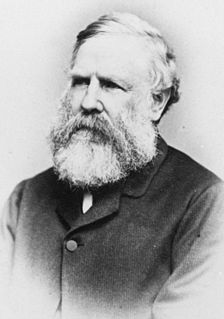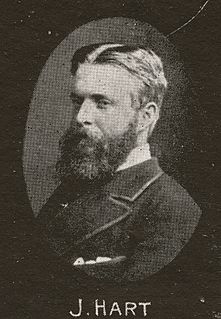
Captain John Hart was a South Australian politician and a Premier of South Australia. His son John Hart, Jr. was inaugural president of the Port Adelaide Football Club and had a brief political career.

Mortimer Luddington Menpes, was an Australian-born British painter, author, printmaker and illustrator.

Thomas Burgoyne was a builder and politician in the early days of the colony of South Australia.

Townsend Duryea and his brother Sanford Duryea were American-born photographers who provided South Australians with invaluable images of life in the early Colony. Their parents were Ann Bennett Duryea (1795–1882), and Hewlett K. Duryea (1794–1887), a land agent, possibly a member of the family well known for starch manufacture in Glen Cove, Long Island, in New York City.

Charles Hervey Bagot, often referred to as "Captain Bagot", was an Irish-born South Australian pastoralist, mine owner and parliamentarian, and was the ancestor of a number of notable South Australian citizens.

John Dunn Sr. was a flour miller in the early days of the colony of South Australia; a parliamentarian, philanthropist and a prominent citizen of Mount Barker, South Australia.
The Bowman brothers were pioneer pastoralists of Tasmania and South Australia. They were the sons of John Bowman : Edmund Bowman, John Bowman, William Charles Bowman and Thomas Richard Bowman.

William Harold Oliver was an Australian rules footballer. Harold Oliver was a key player to some of South Australian football's most successful teams. He starred in South Australia's victorious 1911 Australian football championship along with Port Adelaide's 1914 "Invincible's" team. After being close to retiring from the game after World War I he returned to captain both Port Adelaide to the 1921 SAFL premiership and South Australia in a game against Western Australia. His reputation as an early exponent of the spectacular mark along with his general skill at playing the game saw him regarded as one of the best players South Australia has produced. This is despite never having won the Magarey Medal, somewhat a result of his career being interrupted by World War I.

John Hart Jr. (1848–1881) was a South Australian parliamentarian from 1880 to 1881.

Angelo Nicholas Goucar Congear was an Australian rules footballer who played for the Port Adelaide Football Club in the South Australian National Football League between 1908 and 1922.
Charles John Pavia was an artist and art teacher in South Australia.
This is a list of members of the South Australian House of Assembly from 1896 to 1899, as elected at the 1896 colonial election:

The 1914 Port Adelaide Football Club season was the club's 37th year in the South Australian Football League.
Benjamin Gould was a politician in colonial South Australia.
Henry Lamshed was a farmer and politician in colonial South Australia.

The District Council of Birkenhead was a local government area in South Australia centred on the suburb of Birkenhead. It was gazetted on 22 February 1877 from areas formerly part of the District Council of Lefevre's Peninsula. The council chambers were based out of the Birkenhead Hotel. It absorbed the remainder of the Lefevre's Peninsula council, which had been severely reduced in size by the creation of the Corporate Town of Semaphore, on 7 August 1884. It ceased to exist when it merged with the Corporate Town of Port Adelaide on 7 December 1886 as the Birkenhead Ward, a move supported by the council and the local population.
William Smallpeice Whitington was an early English settler in South Australia, founder of the shipping company Whitington & Co. He emigrated on his own ship New Holland, arriving in South Australia in July 1840. That cargo, which made for him a tidy profit, included Falklandina and Actaeon, the colony's first thoroughbred mare and stallion, the basis of John Baker's racing stud. He brought in South Australia's first steamers: Corsair and Courier, and the brig Enterprise for trading between the colony's ports. The ships went into service just as overland routes were opening up, and proved a costly mistake. He later invested in a number of mining ventures, at a substantial loss. His descendants included a number of notable individuals.

The Corporate Town of Semaphore was a local government area in South Australia. It was created on 20 December 1883, and re-gazetted on 17 January 1884, from areas which had been part of the District Council of Lefevre's Peninsula and District Council of Glanville. The separation of Semaphore would make both its former municipalities unviable, with Lefevre's Peninsula subsequently merging into the District Council of Birkenhead and Glanville with the District Council of Woodville. In 1889, the municipality acquired the Semaphore Institute building for use as the Semaphore Town Hall; the building survives today as the heritage-listed Semaphore Library. It amalgamated with the Corporate Town of Port Adelaide on 11 November 1900.
Malcolm Donald Reid was a South Australian timber merchant and businessman, founder of several furniture stores that bore his name.
Daniel Garlick was an architect in the early days of South Australia. After his death two competing firms of architects claimed his aegis in their partnership names.













